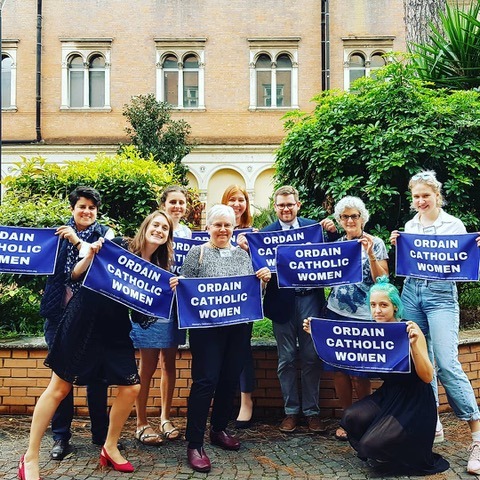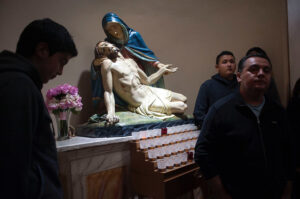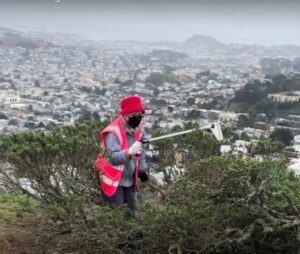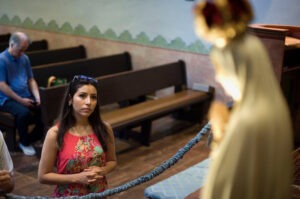The small congregation prayed, sang, and listened to readings from scripture as any other Roman Catholics might do at Mass, rendering particular reverence at the moment of consecration, when the faithful believe bread and wine become the body and blood of Jesus Christ through the words of the priest. The main difference between this Mass and thousands of others I have attended in my life was that the celebrant was a woman.
Rev. Maria Eitz was a slender, mature woman wearing a long dress, with a stone pendant around her neck that caught the light from tall church windows. Eitz preached on social justice, prayed for immigrant children stuck at the border, and quoted Cornell West: “Justice is what love looks like in public.” During traditional requests for prayer, the man next to me said, “Bless the women bishops. The men bishops can only seem to speak about one thing – abortion – when so much else needs attention.”
As a cradle Catholic (baptized as an infant) I felt wary and disoriented at first to see a woman, not a male priest, at the center of the action. But after attending more such Masses, including numerous remote services conducted by women priests during the COVID pandemic, I realized that the central rite of the Catholic Church could feel perfectly normal when conducted by a woman.

“Our circle [of worshippers] has become very deep,” Eitz told me later, speaking of the twelve to eighteen persons who had been meeting with her and another woman priest for more than five years at San Francisco’s St. Cyprian’s Episcopal Church, which affords space for services. Like most other women priests, Eitz had obtained a degree in theology (Master’s, Marquette University) in the years before she studied further for the priesthood with an organization called Roman Catholic Womenpriests (RCWP-US). She was ordained by a woman bishop in 2012, and spoke of the experience as “transformative,” especially the moment when she lay down on the floor in prostration, a sign of humility. “It was a very profound event,” she said. “I knew I could never go back.”
In the worldwide Catholic women priests movement, which includes, besides the RCWP-US, Roman Catholic Womenpriests Europe East, and the Association of Roman Catholic Women Priests, some 270 women have been ordained since 2001, most in the United States, others in Canada, South Africa, Taiwan, the Philippines and countries in Europe and Latin America.
In the United States, the Roman Catholic Church, with 77 million members, has become a house divided. The number of women priests is small but differences over gender equality are emblematic of the split. On one side are adherents to the reforms of the watershed Second Vatican Council (“Vatican II,” 1962-65), held to “let in the fresh air” and consider the Church’s relations to modern world. The Council updated liturgies, recognized other religious traditions, and emphasized the importance of lay participation. On the other side of the divide are traditionalists who abjure reforms such as the use of local languages in rites instead of Latin, and elevate the role of clerics over the laity. The reformers call for attention to social injustice, while traditionalists emphasize personal piety and strict obedience to clergy.

But people who dare to jump the gun and support female ordination risk being expelled from the Church.
Roy Bourgeois, a former naval officer who earned a Purple Heart during the war in Vietnam, became a Maryknoll priest in 1972 and served in poor neighborhoods of urban Bolivia. Back home in Columbus, Georgia, he organized protests outside the U.S. Army base at Fort Benning, Georgia, home of the School of the Americas, where Latin American officers of regimes charged with human rights crimes were trained. Bourgeois was stripped of his priesthood in 2012 for supporting female ordination, and thrown out of his beloved Maryknoll order.
In a telephone interview from Columbus, Bourgeois said he came to realize the “grave injustice” of forbidding the priesthood to women, and began to raise the issue at the many talks he was invited to give at churches and colleges, even during a live segment on Vatican Radio. “It was like poking the beehive,” he said. “I underestimated the depth of the sexism and misogyny of the all-male priesthood.”
Since the Church returned him to a lay state, Bourgeois has continued to work for gender equality in the Church, currently with a billboard campaign paid for by friends: strategically placed on highways, the billboards feature a pleasant-looking Pennsylvania Catholic woman cleric and the words, “ORDAIN WOMEN PRIESTS!”
“God calls everyone to the table as equals, “ Bourgeois wrote in a small 2012 book, My Journey from Silence to Solidarity, something he said he learned in the poor neighborhoods of Bolivia, where liberation theology was practiced. “Doesn’t the call to the priesthood come from God? Who are we, as men, to reject God’s call to women?”
Women often led the small groups of worshippers in the early Christian era. And during the Cold War, when Soviet-allied regimes imprisoned and tortured (male) priests, at least one bishop, Felix Davidek, of what is now the Czech Republic, ordained several women. Recent female ordinations began in 2002, when three bishops agreed to ordain several women who came to be known as the Danube Seven, because they received the sacrament on a boat on the river. They were nuns, theologians, and a former first lady of the state of Ohio.
Only a bishop can ordain a priest. To ensure that women’s ordinations could continue without further compromising male clergy, a bishop whose name has not been made public anointed two of the Danube Seven, Christine Mayr-Lumetzberger and Gisela Forster, as bishops in 2003. Because the ordinations were performed by anointed male bishops, today’s women priests claim they are in an unbroken line of succession descended from Jesus’ original apostles, just as male clergy claim. In 2014 Meyr-Lumetzberger flew from her home in Austria to Brownsburg, Indiana (pop: 22,000), to attend the episcopal ordination of a former Franciscan nun named Nancy Louise Meyer, by another one of the women bishops, Patricia Fresen, who came in from South Africa. Five other women bishops attended.

“We just broke the law,” said Bishop Meyer in an interview. “We have to go outside the institution to be ordained.” Her study for the priesthood was “catacombed,” she said, kept secret from her family because they would have objected, and from the Archdiocese of Cincinnati, her employer.
Meyer, 73, now serves as bishop for the RCWP-US, Midwestern region, with about a dozen congregations in cities and towns from Bowling Green, Kentucky, to Red Wing, Minnesota. She said men and women often attend services in roughly equal numbers. With Zoom and “hybrid” remote and live services, participants come from farther afield than they did before the COVID pandemic.
To Meyer, the single greatest obstacle to female ordination is clericalism, believing that male clerics are superior to laypeople in moral authority, and their pronouncements should remain unchallenged.
“If women were ordained, even if married men were ordained in great numbers, it would change the structure of the Church — it would be a different dynamic.” Women, she said, “have a much different way of looking at how we need to be about bringing folks to God, and not pushing them away because they’re not obeying the law.”
In November Meyer will ordain two women to the priesthood in Davenport, Iowa, including a Brownsburg deacon who is relatively young, age 42, a mother of two children, which Meyer said gives hope for continuing leadership of the local congregation.
The Vatican excommunicates women who take part in the outlaw rites. However the women priests consider themselves faithful members of the Church.
Unlike the RCWP, the women priests’ association, whose members train and ordain female priests, the U.S.-based Women’s Ordination Conference (WOC) believes in going through institutional channels to change the position of the Vatican. Sinc, 1975 the WOC has tried to convince clerics to modify Canon Law so that women may receive the sacrament of Holy Orders legitimately in the eyes of the Church. So far the effort has been unsuccessful, but WOC’s activists persist with 10,000 members and a year-round lobbying agenda.
From her office in Rome, WOC executive director Kate McElwee told me in a Zoom interview that the “most persuasive argument” for women’s ordination “comes when you listen to women themselves who experience the vocation to the priesthood — not only is it a moving testimony, often it’s very painful for the woman who’s experienced this call that’s been rejected.” Moreover, she said, “As Catholics we can’t put a limit on God. That would go against our beliefs.”
McElwee acknowledged a continuing “disconnect with the hierarchy.” The bishops’ attitude against female ordination “impacts women’s lives and livelihoods within the Church, and how fulfilled they feel in their faith,” she said.
Women aspirants to the priesthood often do not want to wait for a process with no guarantee of success while living with what they say is a God-given vocation. “We believe it is most important to follow our consciences,” said Rev. Martha Sherman of Salem, South Dakota, who was ordained by a woman bishop in 2013 in St. Cloud, Minnesota.
Not every Catholic woman yearning for greater participation in the Church of the future wants the chance to be a priest. With a force as strong as any other call, they say, some want to be ordained deacons, a position with many priestly responsibilities. Some 47,000 deacons, all male, serve worldwide, 18,000 of them in the United States.
Delila Vasquez, 60, of Fontana, California, has studied theology, taught Confirmation classes and serves as the CEO of a Catholic professionals’ organization. She recently asked her husband Roberto, “Would you support me if I want to become a deacon when that opens up for women?”
Vasquez laughs when she remembers how her husband was taken aback, suggesting the whole family might talk about it first – they have three adult daughters. But Delia and Roberto Vasquez have been married for thirty years, attend Mass regularly, and she is confident he will agree, having heard and seen “my passion.”
“I know that in my heart,” she said.
Deacons baptize, celebrate weddings, anoint the sick and bury the dead, proclaim the Gospel and preach during Mass. As of now only men, including married men, are eligible. A wife gives formal consent to her husband’s ordination, and is expected to help in some of his duties, to model a Christian marriage. That is why the assent of Vasquez’s spouse is important.
Bishops are dragging their feet. Fully sixty percent of American Catholic women reported support for the idea of female deacons in a 2017 survey conducted by the Center for Applied Research in the Apostolate (CARA) at Georgetown University. The next year CARA surveyed superiors of male and female religious orders; seventy-six percent of those who replied said women deacons would benefit the Church. Some bishops do support the idea, among them San Diego Bishop Robert McElroy, who has told the National Catholic Reporter, “women should be invited into every ministry or activity we have that’s not doctrinally precluded.” In 2019, however, only a third of bishops who answered a CARA survey thought the Church should ordain women as deacons, and even fewer (twenty-seven percent) thought it would do so.
The conversation moves at a snail’s pace inside the Vatican. In 2016, at the behest of superiors of women’s religious congregations, the pope appointed a panel of twelve experts, six men and six women, to consider the women’s diaconate. After presenting “the little they agreed on” to the sisters in 2019, he appointed another panel in 2020 with a new set of members.
Opponents say allowing women deacons is just the camel’s nose under the tent, a move toward forbidden priestly ordination. The original twelve apostles were male, they say, suggesting this means females cannot succeed them, and that Jesus was male, so a woman cannot “image” him, even as a deacon, cannot mirror him as the man he was on earth.

Theologian Phyllis Zagano of Hoffstra University, who was a member of the first Vatican panel, maintains that such thinking is heretical, because the Church teaches that the resurrected Christ is God, and as every Catholic school child learns, he or she, male or female, disabled or in any other way limited in life, is made in the “image of God.”
“The Holy Father sees Christ in all people,” Zagano said, referring to Pope Francis, in a Zoom address to a recent session of Future Church, a 25-year old initiative that supports “responsible change” including married and women priests. “And that is what we are called to do. To see Christ in every single individual we meet.”
As the debate continues, Delia Vasquez said she is watching young members of her parish drift away, telling her they find the Church “patriarchal” or “irrelevant.” For the Latino Catholic population – Vasquez migrated from Ecuador and her husband is Mexican American – Vasquez said, “our youth would benefit from seeing women at the altar alongside the priest.”
How the altar looks to Latinos is no small consideration. A majority of U.S. Catholics under thirty are Hispanic, and Latinos are the U.S. Church’s fastest growing population.
“In the Latin culture the mom has influence,” Vasquez said. If women are deacons, “young people could see women in the leadership of the Church. I see it with other denominations where there is a woman preacher. I hear young women describe the preacher as a woman first, and then the role. There’s something to be said about that.”
When Vatican II encouraged Church participation by lay people, women began to study for advanced degrees in theology, anticipating more leadership and pastoral roles. In classes of some graduate theology schools women now make up as much as 50 percent of students, and many professors are women. Some graduates become certified pastoral ministers – for the sick, or for college students, for instance — or educators and other kinds of parish leaders. Some become spiritual directors, trained in theology, scripture and psychology, and accompany individuals to see how God is working in their lives, including in times of stress or grief.
Others, like Kristi Laughlin, a social worker, have used their studies and experience in families, or at work, or as members of religious orders, to preach at Mass.
“It was great,” Laughlin remembered of the first time she preached at Holy Spirit Parish in Berkeley in 1996. She focused on the moment in Scripture when Simon Peter recognized Jesus as the Messiah, and Jesus replied by giving him the keys of the kingdom of heaven. “I explained how we are all entrusted with the kingdom,” she said, men and women, rich and poor, fit or struggling with illness. “It just gave me such joy.”
Over the years, Popes John Paul II (1978-2005) and Benedict XVI (2005-2013) and conservative bishops chipped away at the laity’s role. Vatican regulations appeared that forbid lay people from reading the Gospel during mass and preaching, unless permitted by the bishop. In 2013 when a new bishop took over the Oakland diocese, to which Laughlin’s parish belongs, he took away permission for anyone but a priest or a deacon to reflect on Scripture during Mass. Since then, Laughlin has preached at the churches of other denominations, but not at a Catholic church.
Silencing women preachers (and lay men, fewer in number) has taken place at other U.S. dioceses too. Archbishop Harry Flynn of St. Paul – Minneapolis, preparing to hand over his office to a more conservative successor in 2008, instructed 29 parishes to end their lay preaching programs, which had been active for a quarter century. In Rochester, New York, women had been giving sermons at parishes since the 1980s while carefully observing, along with their pastors, the letter of canon law by preaching “in dialogue with” the presiding priest, describing their insights as “reflections,” not homilies, which are reserved to priests or deacons. The conservative bishop Salvatore Matano took over in 2014 and ended the forty-year old practice.
When Jean Molesky-Poz, who had preached at Holy Spirit for twenty years, heard about the silencing order she remembers thinking, “Really? The only place we can never proclaim the Gospel is at Mass?”
Molesky-Poz said she was “totally surprised, taken off guard, disappointed.”
“It was as if the Church had been given a gift,” she said, “and at a certain point the hierarchy said, ‘We don’t really want it any more.’”
Kristi Laughlin was “stunned.”
“If you know we all refract the light of God, doesn’t that call us then to invite more witnesses, more preachers, more people to leadership?”
Not only the women preachers, but parishioners were dismayed. Peg Bogle, an educational therapist and mother of two adult children, said that the first time she heard a woman preach, she thought, “Oh my gosh, this is what I’ve been missing all these years. Someone that looks like me, and has my kind of life. They can talk from a woman’s perspective.” Bogle saw the silencing as one more sign of division in the Church. “If we don’t move toward women in leadership, if we don’t move toward priests — whether men or women — having the option to be celibate or not, we are going to be stuck in the middle medieval times,” she said. “It’s just not sustainable.”
One of the preachers, Kara Speitz, who is in her 80s, went personally to speak with Oakland’s bishop Michael Barber in his office and found common ground discussing Dorothy Day, the political radical and champion of the poor who founded the Catholic Worker movement, to which Speitz belongs and the bishop admires. But he held his ground. “He’s a rule follower,” Speitz said.
For Kristi Laughlin, being forbidden to preach, “a real source of pain,” was the last straw in a series of disappointing experiences over years at the hands of overweening bishops and pastors, from the firing of a beloved woman campus spiritual director – despite strong student protests – to having the door shut on efforts to organize a parish faith discussion group for young women. Laughlin explored other denominations, but said that they felt to her like “Catholic lite,” without the pull and depth of the beliefs into which she was baptized. Nevertheless, she has decided to stop raising her 11-year old son as a Catholic. “I wanted my son to be raised in the faith, to have a relationship with God, but I could no longer reconcile that with bringing him into a church where he was never going to see a woman at the pulpit,” she said.
Disheartened women may give up Catholicism to become Episcopalian or embrace other Christian denominations which have female clergy.
“It’s a tragedy for the women who offer gifts that aren’t accepted, and it’s a tragedy for the Church that is not taking advantage of all the gifts that are available,” said theologian Alison M. Benders, a former associate dean at the Jesuit School of Theology in Berkeley.
Recognizing women fully, as priests, deacons and preachers, with all the dignity the positions imply, might be an example to the world, Benders said. Others could be “influenced” by the example of the Church, with its 1.3 billion members across the globe.
“It’s a tragedy to think that it’s OK to categorize and ignore the full humanity of some people,” she said. “That’s not what our God does.”
Mary Jo McConahay examined the role of women in the Catholic church during her fellowship year. Her work contributed to her latest book, “Playing God, American Catholic Bishops and the Far Right.” (Penguin/Random House).




